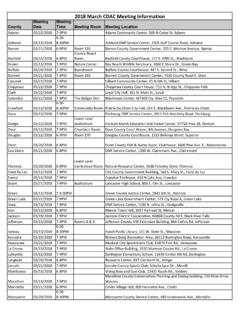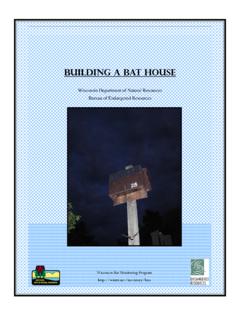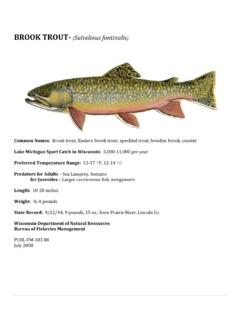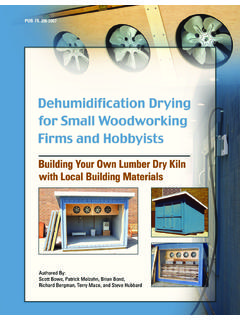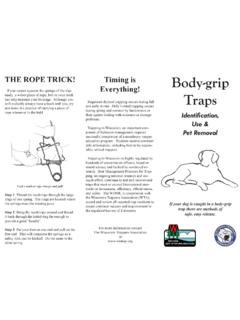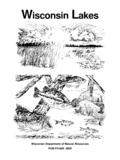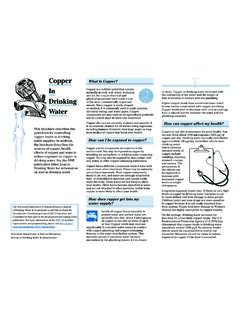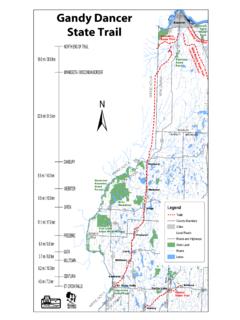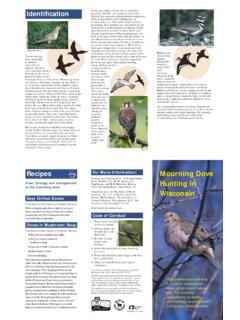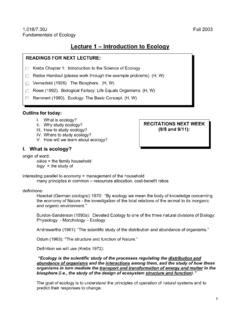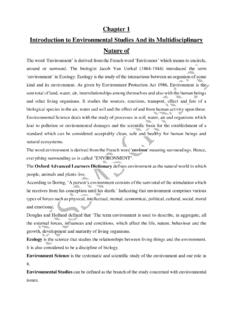Transcription of Trapper Education Manual - Wisconsin Department of …
1 Wisconsin Cooperative Trapper Education ProgramSTUDENT MANUALA dditional PublicationsThe following publications are to be used as supplements to the Trapper Education Manual :Avoidance Brochures/BookletsMarten AvoidanceOtter AvoidanceLynx AvoidanceTrapping and Furbearer MgmtCable Restraint BookletFur Handling DVDWI Trapping RegulationsTrapping and Furbearer MgmtNTA Trapping HandbookMammal Tracks on WisconsinDiseases of WI FurbearersBody-grip Traps BrochureCable Restraint BrochureTrapping in the 21st CenturyFurbearer ManagementiWisconsin Cooperative Trapper Education ProgramStudent ManualThis Education program is the result of hours of dedication and commitment from
2 Individuals in the wildlife profession, and is truly a cooperative effort between citizens of Wisconsin as well as federal and state agency personnel. The primary theme was an interest and desire that future generations enjoy the same furbearer trapping opportunities we have today. The Wisconsin Department of natural Resources (WDNR) and the Wisconsin Trappers Association (WTA) through the Wisconsin Cooperative Trapper Education Program (WCTEP) are charged with execution of this effort. Our gratitude extends to the Association of Fish and Wildlife Agencies (AFWA) and North Dakota Game and Fish Department for providing the blueprint to this Manual ; and the WTA, WDNR and Wisconsin citizens for acknowledging the importance of regulated, science-based furbearer trapping by providing the resources and financial support for the program.
3 Individuals deserving such recognition include:John Irwin, Former Wisconsin Trappers Association (WTA) PresidentScott McAuley, Former WTA PresidentJohn Olson, Furbearer Specialist, WDNRS hawn Rossler, Assistant Furbearer Specialist, WDNRV irgil Schroeder, Current WTA PresidentNicke Shumaker, Former WTA-WCTEP Statewide CoordinatorRick Tischaefer, North Dakota Fur Hunters & Trappers Association (NDFHTA)Mike Widner, WTA-WCTEP Correspondence CoordinatorBill Vander Zouwen, ecology Section Chief, Wisconsin Department of natural Resources (WDNR)
4 In addition, we express our sincere appreciation to Pat Beringer, Dennis Brady, Dan Carroll, Joe Dragon, John Gillen, Lesa Kardash, Jolene Kuehn, Junior Prudlick and Scott Loomans for their dedication and countless volunteer hours committed to this program. It is that volunteer spirit and quality leadership that serves to ensure future generations have the same furbearer trapping opportunities we have and photographs are protected by copyright laws. Information on reproduction rights and privileges is available from the Association of Fish & Wildlife Agencies and the Wisconsin Department of natural Resources.
5 Cover photo: Scott NielsenSecond EditioniiWisconsin Trapper Education ManualTable of ContentsUNIT IChapter 1 - Introduction to Trapper Education .. Objective - Students demonstrate an understanding of the purpose of trapping and Trapper Education in today s 2 - Historical Considerations .. Objective - Students use knowledge of history, public attitudes about wildlife, and the North American Model of Wildlife Conservation to understand regulated trapping as a legitimate 3 - Responsible Trapping .. Objective - Students demonstrate an awareness of their responsibilities to landowners, wildlife, other outdoor users and the 4 - Wisconsin s Furbearer resource .
6 Objective - Students demonstrate an understanding of Wisconsin furbearer 5 - Furbearer Management .. Objective - Students use knowledge of furbearer management principles , practices and issues to describe current management programs in 6 - Wisconsin Trapping Regulations .. Objective - Students demonstrate the ability to understand, support and comply with trapping I Review ..UNIT IIChapter 7 - Best Management Practices .. Objective - Students understand Best Management Practices for Trapping were developed to address animal welfare, trapping efficiency, selectivity and safety in furbearer management 8 - Traps and Trap Preparation.
7 Objective - Students demonstrate the ability to identify types of traps, prepare traps for use, and safely operate 9 - Trapping Equipment .. Objective - Students identify essential and nonessential equipment and clothing used to set traps and run a trap 10 - Using Bait, Lure, and Urine .. Objective - Students explain responsible use of lures, bait and urine to attract furbearers to 11 - Water Sets .. Objective - Students demonstrate an understanding of the procedures for making safe, effective and selective sets in or near 12 - Land Sets.
8 Objective - Students demonstrate an understanding of the procedures for making safe, effective and selective sets on land. 1 6 14 23 52 62 66 68 72 90 97101111iiiChapter 13 - Cable Devices .. Objective - Students demonstrate an understanding for using cable restraints and cable II Review ..UNIT IIIC hapter 14 - Trapping Safety .. Objective - Students demonstrate an understanding of potential risks to their personal health, safety and welfare from trapping 15 - Running a Trap Line .. Objective - Students demonstrate an understanding of the knowledge, skills, and attitudes needed to safely and responsibly harvest furbearing animals using Best Management 16 - Handling Fur.
9 Objective - Students demonstrate an understanding of the knowledge, skills and equipment needed to safely skin animals and prepare pelts for 17 - Marketing and Utilizing Furbearers .. Objective - Students demonstrate an understanding of the full value of harvested III Review .. chapter 18 - Glossary .. chapter 19 - References.. chapter 20 - Appendix .. 121132134145152168176178181184ivThe Department of natural Resources is committed to serving people with disabilities. If you need this information in an alternative format, please call 1982, the Wisconsin Trappers Association (WTA) in cooperation with the Wisconsin DNR, began a statewide program of voluntary Trapper Education .
10 That program recognized that many inexperienced trappers were sincerely interested in trapping responsibly, but they lacked any available source of direct information. Due in part to the successes of the volunteer program and the importance to keep all new trappers informed of current regulations and techniques, Trapper Education became mandatory for all first time trappers in 1992. The program was revised and designated as The Wisconsin Cooperative Trapper Education Program (WCTEP). The WCTEP has a proud history of providing quality trapping resources and Education to new and experienced trappers alike.

